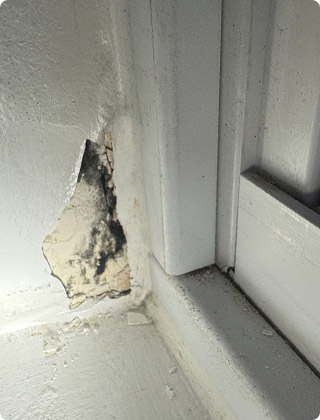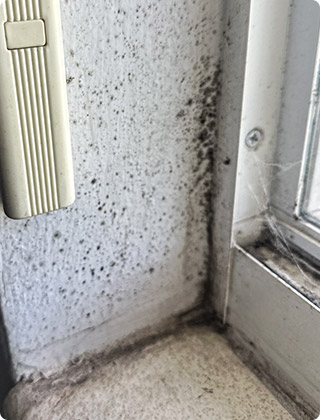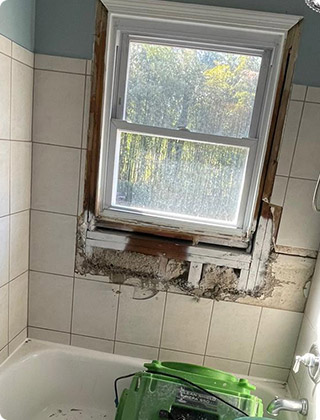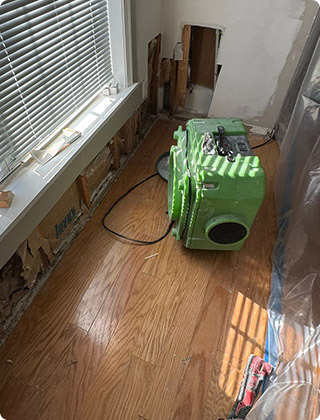
Windowsill Mold: Small Spots That Can Hide Big Mold
If you've ever noticed tiny black or greenish spots gathering near your window frame, it's easy to shrug it off. "Just a little dust" - you might think. But those small splotches could be mold - and not the kind that stays put. At O2 Mold Testing, we've seen it time and time again: what looks like a minor issue around a window often signals a much bigger problem hiding in the walls, insulation, or even the air you breathe.
Let's dig into what causes mold on windowsills, why it shouldn't be ignored, and how professional mold testing can reveal the truth behind the stains.
Why Mold Forms on Windowsills
Windowsills may not seem like troublemakers, but they're one of the most common places for indoor mold to take hold. Why? Because they quietly check off every box mold needs to grow: moisture, poor airflow, and something organic to feed on.
It often starts with condensation - those tiny water droplets that form when warm indoor air hits the cold surface of the glass. This is especially common during winter months or in humid climates. That water trickles down and settles on the sill, soaking into porous materials like wood, drywall, or paint.
If your windows are leaky or poorly sealed, the problem compounds. Rainwater or outside humidity can sneak in and linger, especially in older homes or those with aging caulking.
Even the airflow around windows can be a problem. Curtains, blinds, or tightly shut rooms can trap stagnant air, keeping the area damp for longer.
Add in some everyday dust and organic particles - like pollen, pet dander, or even dead skin cells - and you've got a feast for mold spores. From there, it's just a matter of time.
In short, your windowsills are doing a lot more than framing your view - they might be silently feeding a mold colony.
What Does Windowsill Mold Look Like?

Windowsill mold doesn't always scream for attention. In fact, it's often sneaky - starting as a faint discoloration that's easy to overlook until it spreads. You might see tiny black specks, greenish smudges, white fuzz, or even orange or pink streaks, depending on the mold type and surrounding materials.
Sometimes mold hides in plain sight, blending into wood grain, caulking, or even behind a fresh coat of paint. In other cases, it shows up as peeling or bubbling paint, which can be a red flag for deeper moisture damage underneath.
Common appearances include:
- Black dots or patches (often mistaken for dirt or mildew)
- Green or gray smudges along the caulk line or corners
- White powdery residue that returns after wiping
- Orange or pink hues in moist, sunlit sills - usually bacteria or mold hybrids
If you've cleaned it once, only to have it come back - that's mold. And it's not just a surface issue anymore.
The tricky part? The visible mold is usually just the beginning. Like the tip of an iceberg, it can hint at a much larger problem growing behind the wall, under the sill, or in nearby insulation. That's where professional testing becomes critical.
Is It Dangerous? Or Just Ugly?

At first glance, mold on a windowsill might just seem like an eyesore - annoying, maybe even embarrassing, but not necessarily harmful. Unfortunately, mold isn't just a cosmetic issue. Even small patches can release spores into the air, where it can spread easily to other damp areas and start to grow, spreading the mold.
For some people, especially those with allergies, asthma, or compromised immune systems, even minor exposure can trigger symptoms of mold exposure like:
- Sneezing
- Coughing
- Itchy eyes or skin
- Headaches
- Fatigue
And if the mold is one of the more aggressive types - like Aspergillus, Penicillium, or in rare cases, Stachybotrys (commonly called black mold) - the health risks can become more serious with prolonged exposure.
But health aside, there's also the potential structural damage to think about. What starts as a patch on the sill can spread behind the trim, into the drywall, and even into the insulation or framing. Over time, this can lead to warping wood, crumbling walls, and moisture-compromised materials that invite even more mold to move in.
So yes - while it might look like a small problem, windowsill mold can carry some big consequences if ignored.
Surface Window Mold vs. Hidden Mold
Not all mold is created equal - and not all of it stays where you can see it. That little patch of mold on your windowsill? It might just be the visible part of a much larger issue brewing beneath the surface.
Surface mold is the kind you can see and, in some cases, wipe away. It usually appears after condensation or minor water exposure and might seem harmless at first. But if it keeps coming back, it's a sign that moisture is lingering - and that's a red flag.
Hidden mold, on the other hand, is the real troublemaker. It thrives in areas you can't easily inspect - behind the trim, inside the wall cavity, under the sill, or in the insulation. Once it spreads beyond the surface, no amount of scrubbing on the surface will stop it from returning.
Common signs that hidden mold may be present:
- Mold regrows after cleaning
- Musty odor that doesn't go away
- Soft or warped wood near the window
- Discoloration or bubbling in nearby paint or drywall
- Unexplained allergy-like symptoms indoors
The big takeaway? Just because you only see mold on the sill doesn't mean that's where it stops. And guessing won't cut it - you need proper testing to know what's really going on. That's where our mold inspection team comes in.
When to Get a Professional Mold Test

So, when is it time to stop cleaning and start investigating? If you've spotted mold on your windowsill once or twice, it might seem like no big deal. But if it keeps coming back - or if something just feels off - a professional mold test can give you the answers you can't get from a bottle of bleach.
Here are some clear signs it's time to bring in the pros:
- The mold keeps returning no matter how many times you clean it.
- Multiple windows are affected, not just one.
- There's a musty odor that lingers even after you air the place out.
- You notice symptoms like coughing, sneezing, or headaches that seem to improve when you're away from home.
- The surrounding wall or trim feels soft, warped, or damp to the touch.
- You're planning to sell or renovate your home and want a clean bill of health.
Professional testing doesn't just confirm that mold is present - it tells you what type of mold you're dealing with and whether it's part of a bigger hidden problem. It can also detect mold spores in the air, which you won't see with the naked eye.
Bottom line? If your windows are waving red flags, don't ignore them. A mold inspection now can save you thousands in repairs (and plenty of headaches) down the line.
How O2 Mold Testing Can Help
At O2 Mold Testing, we don't just guess - we get answers. If mold is creeping around your windowsills, we dig deeper to uncover the full picture. Because where there's visible mold, there's often more hiding out of sight.
Here's how we help you take the guesswork out of the equation:
- Air sampling detects invisible mold spores floating through your home's air, helping us understand how far the contamination may have spread.
- Surface and swab testing identify the exact type of mold growing on your windowsill - whether it's relatively harmless or something more aggressive.
- Moisture detection tools like thermal imaging and moisture meters help us track down hidden damp areas behind walls, under window frames, or in insulation.
- Clear lab analysis gives you an official report you can trust, outlining what we found and what actions (if any) are needed.
Our inspections are quick and professional. Just clear, science-backed answers to help you make informed decisions for your home and health.
Whether it's a one-room concern or a whole-house check, O2 Mold Testing delivers peace of mind. And if remediation is needed, we can connect you with trusted experts who'll take care of it safely and thoroughly.
Don't Let a Small Spot Become a Big Problem
Mold on your windowsill might look minor, but it's often a sign of a much deeper issue - one that could be affecting your indoor air quality, your health, and your home's structure. The worst part? You won't always know how far it's spread just by looking at the surface.
That's where O2 Mold Testing comes in. We help homeowners like you get real answers with professional mold inspections that go beyond guesswork. Whether it turns out to be a minor issue or something more serious, at least you'll know - and you'll be one step closer to a cleaner, safer home.
Seen suspicious spots around your windows? Don't wait until it spreads. Book a mold inspection with O2 Mold Testing today and let us help you see what's really going on behind the surface.
Frequently Asked Questions
Can Mold Grow Between Window Panes?
Yes, mold can grow between window panes if moisture gets trapped inside, often due to seal failure in double- or triple-pane windows. Condensation between the glass creates a damp environment where mold thrives. Professional repair or window replacement may be needed to resolve the issue.
Will Repainting a Windowsill Kill Mold?
No, repainting alone won't kill mold. Mold must be fully removed (using a bleach solution, vinegar, or commercial cleaner) and the underlying moisture problem fixed before repainting. Otherwise, mold can regrow underneath the new paint. Use mold-resistant paint for prevention.
Can I Clean Mold Off a Windowsill Myself?
Yes, you can clean mold off a windowsill yourself if the infestation is small. Use a mixture of water and bleach (1:10 ratio), vinegar, or hydrogen peroxide. Scrub with a brush, dry thoroughly, and address the moisture source (e.g., leaks, condensation) to prevent regrowth. For severe mold, consult a professional.


